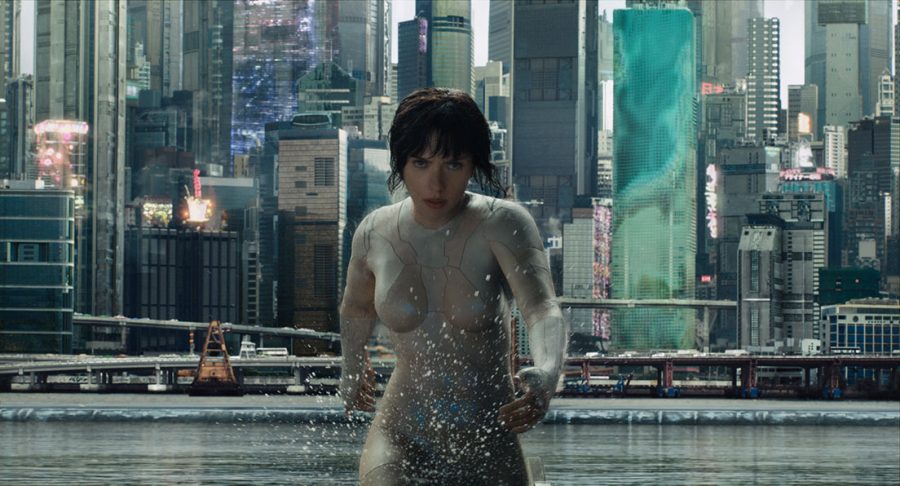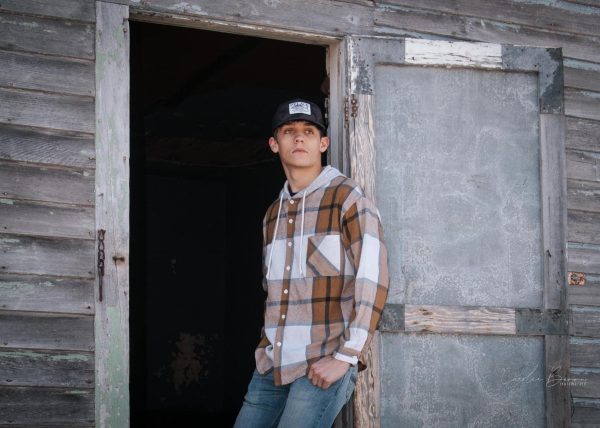‘Ghost in the Shell’ has big shoes to fill for anime fans
Scarlett Johansson plays The Major in "Ghost in the Shell." (Paramount Pictures/DreamWorks Pictures/TNS)
March 29, 2017
The opening moments of the new “Ghost in the Shell” — a minute-and-a-half establishing shot of its futuristic city and its hero, The Major (Scarlett Johansson) — could have taken quite a bit of time if it had been done on only one computer, said the film’s visual-effects supervisor, Guillaume Rocheron. “About 33 years,” he guessed.
Luckily, they had more than one computer.
“Ghost in the Shell,” which opens Friday, March 31, involves crime, intrigue and Major’s realization that her life was stolen when she was made into a cyber-enhanced crime-fighting machine. It is intended to amaze with its transformation of the beloved 1995 animé into a live-action Hollywood spectacle. But Rocheron said the intention was also to do as much “practically” as they could.
“We tried to be as tactile as possible,” he said, “which was always Rupert’s mission.”
Director Rupert Sanders (“Snow White and the Huntsman”), along with Rocheron and the rest of their filmmaking team, were under quite a bit of pressure: The animated Japanese version, directed by Mamoru Oshii (and adapted from the popular manga, or comic book), has an enormous cult following. It was just released on BluRay / HD digital by Anchor Bay Entertainment with a limited edition steelbook and exclusive Mondo artwork (there have been numerous other films and TV series, as well). To say it has a fan base is to do it an injustice: “Ghost in the Shell” broke new ground — for fans, and for the Japanese animation industry — when it hit U.S. shores almost exactly 19 years ago this month. A generation of animé lovers were exposed to it at an impressionable time in their movie-consuming careers.
“Oshii’s ‘Ghost in the Shell’ arrived on the Western radar at a perfect moment — and not just by capturing so many of the tropes and concerns of the cyberpunk movement,” said Rupert Bottenberg, programmer of the Axis animation section at Montreal’s Fantasia film festival, and who presented and interviewed director Oshii there two years ago. (“I was reading Masamune Shirow’s mangas in the late ‘80s, well before the animé.”)
Bottenberg said that Saturday-morning and after-school cartoons had familiarized kids with the animé style and sensibility, but the quality of Japanese animation, since the ‘60s, had been all about “cutting corners.” When the sophisticated “Akira” hit screens in 1988, it was a revelation. But it took “GITS” in 1995 to show that “Akira” wasn’t a fluke, that the Japanese animation industry had metamorphosed into something far more technically advanced.
“The streak of sexiness and the du-jour cyberpunk themes were important, of course,” Bottenberg said. “But Oshii’s removed, abstracted, philosophizing tone confirmed what ‘Akira’ had suggested — that cartoons no longer needed to be synonymous with kooky and cuddly.”
Given the impact of “GITS,” a live-action remake assumed immediate baggage.
“I knew it would be impossible to simply remake the original,” said Sanders. “We had to find a story that felt part of the world, part of the legacy, and not just a recreation. My approach was to adapt and yet honor the original material.”
Sanders’ “Ghost in the Shell,” which co-stars Juliette Binoche and Michael Pitt and was written by Jamie Moss, became controversial as soon as Johansson was cast as the lead: That a non-Asian would be playing the principal character in the remake of such an iconic Japanese story struck many as just another case of Hollywood “whitewashing.” However, Oshii has apparently given his blessing to Johansson, and the cast does include several Asian stars, including one of the biggest, the actor and director Takeshi Kitano.
“I grew up watching the films of Takeshi-san, from ‘Merry Christmas Mr. Lawrence,’ to ‘Sonatine’ to ‘Hana-bi,’ “ said Sanders, “and when first casting for the role of Aramaki there was no one else in my mind. It was a challenge to schedule, he is always busy, but I was incredibly persistent and wouldn’t take no for an answer. Even when I had to tell the studio that he would only speak in Japanese, I wouldn’t back down.”
At the world premiere of “Ghost in the Shell” in Tokyo, a news conference brought together members of the international cast, including Kitano and Johansson.
“Appearing in a real Hollywood film with a big budget was a very good experience for me; Scarlett taught me how to behave when working as an actor,” said Kitano, who has about 64 acting credits and is something of a one-man entertainment empire in Japan.
For her part, Johansson left any controversies to others. “This film was a labor of love for all of us, and it’s a property that’s beloved by all of you,” she told the Japanese media. “And it feels very fitting and deeply touching to bring this film here for the world premiere.”
SIDEBAR: GOING LIVE-ACTION IS NO SURE BET
“Ghost in the Shell” is the latest animated property to undergo the transformation process into a live-action movie — and to judge by last week’s monster opening of “Beauty and the Beast” ($170 million), it’s a pretty smart strategy. On the other hand … as these examples show, a cartoon going “live” can lead to anything from joy to disaster:
101 DALMATIANS (1996) A dog. In revisiting the 1961 animated Disney film, Stephen Herek had at his disposal a script by John Hughes and a leading lady in Glenn Close as Cruella De Vil, but it hardly gave the old imperiled puppy movie a new leash on life. However, reports last year said yet another “Dalmatians” is reportedly on the non-drawing board, one which — a la “Wicked” or “Maleficent” (another live-action remake) — will be a prequel about how Cruella got that way. The alleged title: “Cruella.” The alleged star: Emma Stone. We’ll see.
THE CAT IN THE HAT (2003) First it was the beloved Dr. Seuss book of 1957, then the 1971 animated TV show, then, most notoriously, it was the movie starring Mike Myers, which we don’t even like to think about. Cloying, vulgar and boring, the film is — as Leonard Maltin’s movie guide puts it — “a betrayal of everything Dr. Seuss ever stood for.”
HOW THE GRINCH STOLE CHRISTMAS (2000) Another assault on Dr. Seuss, this vehicle for Jim Carrey used gross-out humor, awkwardly adult references and an overly antic approach to the gentle Seuss tale to make an inadvertent tribute to Chuck Jones’ 1966 masterpiece of concision and wit.
ALICE IN WONDERLAND (2010) One of the more iconic Disney animations of the early years and yet another based on a literary chestnut (Uncle Walt always liked material that was in the public domain). When Lewis Carroll’s story got the phantasmagorical Tim Burton treatment, so did Johnny Depp, Mia Wasikowska and Helena Bonham-Carter — all of whom returned for last year’s “Alice Through the Looking Glass.” Burton apparently has his heart set on a live-action “Dumbo.” We tremble with anticipation.
THE JUNGLE BOOK (2016) A revelation and a movie destined for repeat viewings by multiple generations, Jon Favreau’s adaptation of the Rudyard Kipling adventure stories — which were the basis for the Disney cartoon movie of 1967 — uses state-of-the-art animatronics and graphic imagery to immerse the viewer and its young hero, Mowgli (Neel Sethi) in the forests of India, and the “law of the jungle.” Bill Murray, Ben Kingsley, Idris Elba and Lupita Nyong’o provide voices.
———
©2017 Newsday
Visit Newsday at www.newsday.com
Distributed by Tribune Content Agency, LLC.








